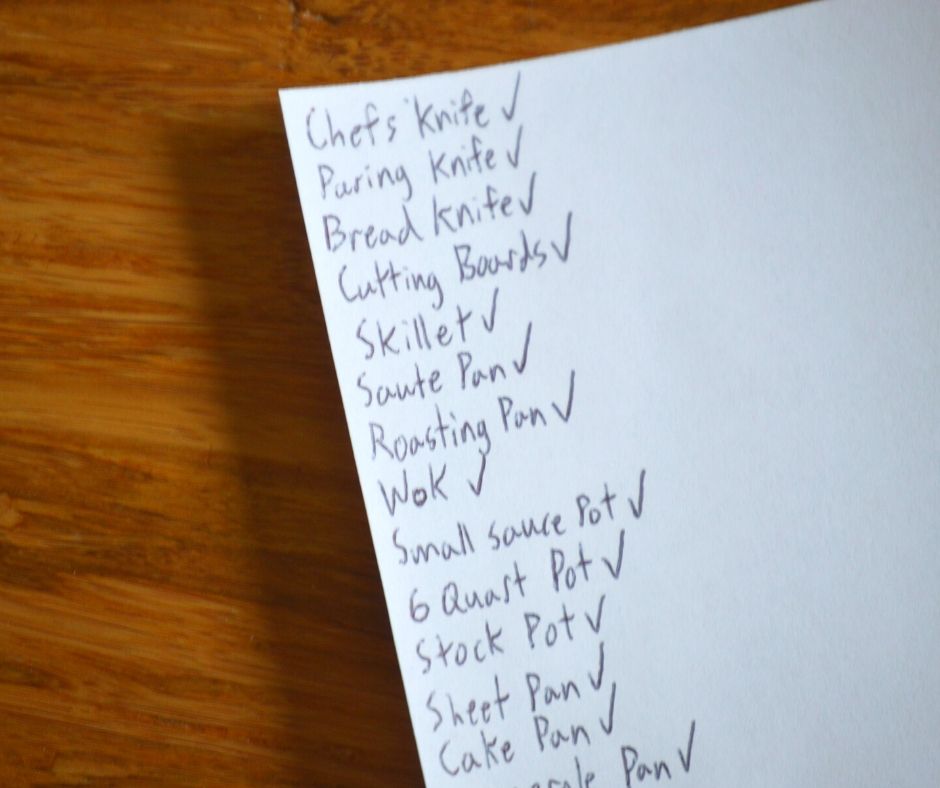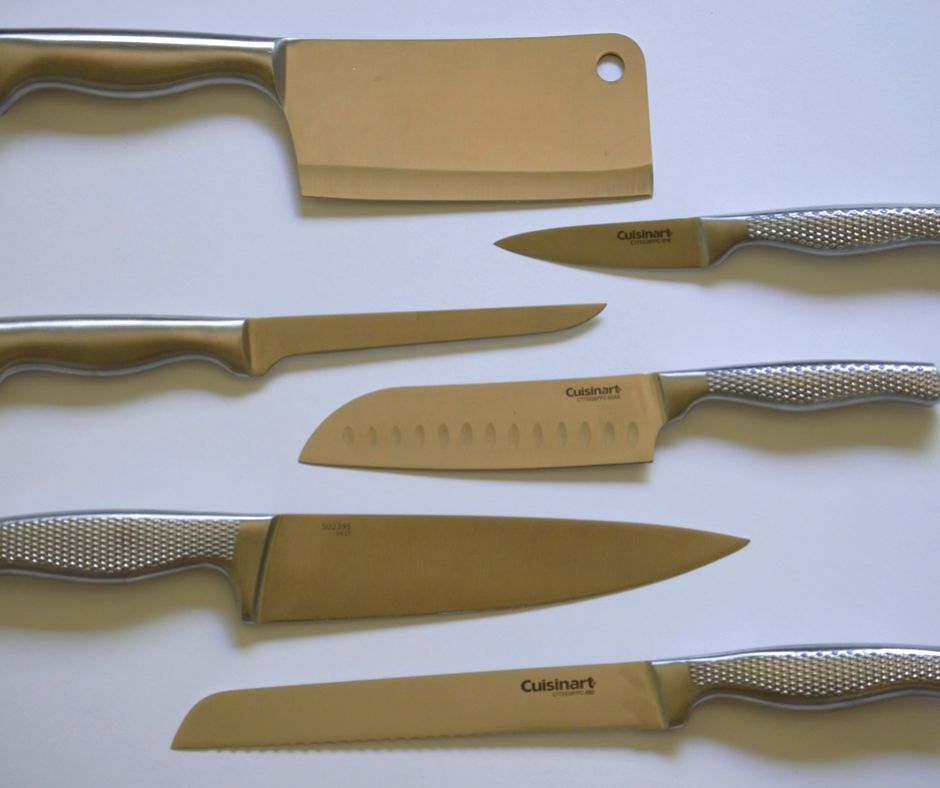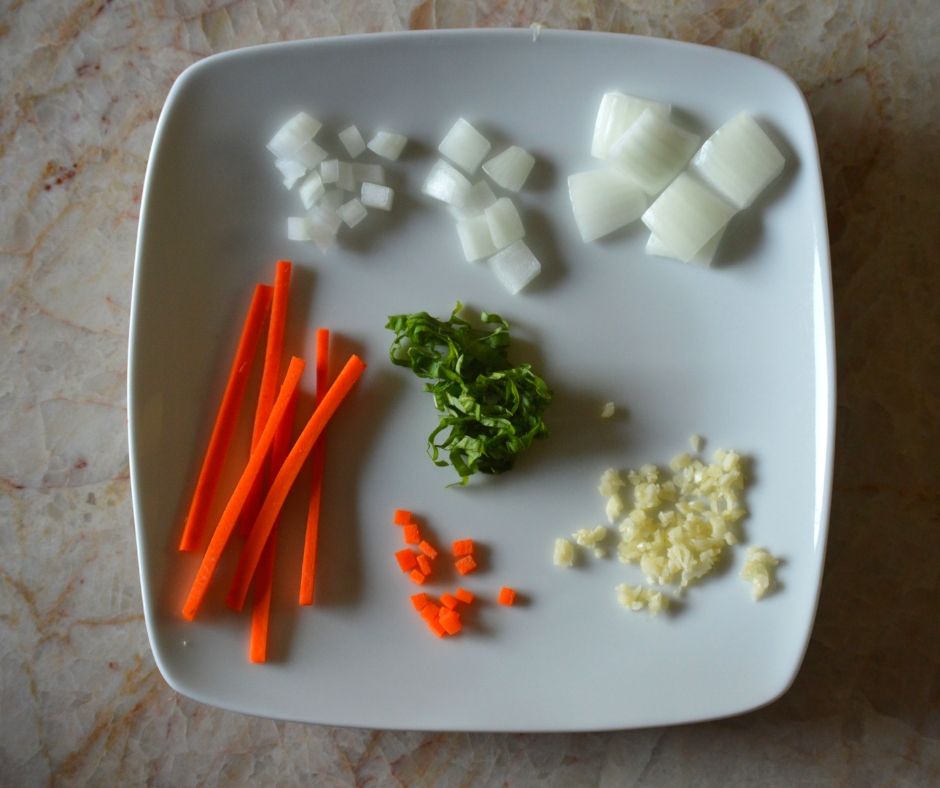
If you are a new cook and haven’t spent a lot of time in the kitchen, then chances are you often get confused by the many different cooking terms used in recipes. Don’t feel ashamed or embarrassed that you don’t know all of the lingo, we all had to learn it from someone at some point in our life. In today’s lesson, I will be doing just that, by attempting to give brief explanations for some of the most common cooking terms you will need to know in order to cook. Now, I know that this isn’t a complete list of cooking terms and that some of my explanations might make sense to me, but not to you folks. So, if you have any suggestions for new terms, or would like further explanations of the terms that are already listed, then please comment below and I will add to this list.
Al dente – A term that comes from the Italian language that translates as “to the tooth”. The term specifically refers to cooking pasta a little less than fully done, so that it still has a firm bite to it, instead of cooking it till it is soft. Sometimes the term “Al dente” is also used to refer to vegetables that are a little undercooked, instead of all the way through.
Aromatics – A term that refers to a combination of either herbs, spices, and or vegetables that are used to form the basis of flavor for a dish. This is accomplished by cooking the aromatics in some type of fat (butter, or oil) over high heat at the beginning of the cooking process. By doing this the aromatics release flavors which infuse with the fat, and give off strong aromas, which is why they are termed “aromatics”
Bake – Also referred to as roasting, is a way to cook food by exposing it to dry heat over a prolonged period of time. The most often way for you to bake in your kitchen is an oven, but in theory, any way of cooking that revolves around cooking something with dry heated air is technically baking. As for the difference between the terms bake and roast, typically when you use this method to cook bread or other types of dough it is called baking, while when you use this method to cook meats and vegetables is often referred to as roasting.
Baste – A cooking technique in which one pours liquid over a piece of meat or vegetables that are being cooked using dry heat. Often the liquid being used to baste is the fat juices from a cut of meat, but it can also be a marinade or a sauce. There are two general purposes of basting, first is to add flavor to whatever is being cooked. And second is to help a cut of meat to stay moist while cooking. You can baste things either by spooning the liquid over the meat/vegetables or you can use a kitchen tool called a baster
Blanch – A cooking process in which a piece of food, most often vegetables, are cooked quickly in boiling water, and then removed and placed into a bowl of ice water. The purpose of blanching is to cook something to its desired doneness and then use the ice water to stop the cooking process. The ice water bath is also used to help certain vegetables, such as green beans, from losing their vibrant color.
Boil – A way of cooking something by exposing it to wet heat, or in less scientific terms hot water. Boiling is similar to simmering, and poaching, but differs from the other two by the temperature at which the water is while cooking. To be specific, the boiling point of water at sea level is 212 degrees Fahrenheit but is lower at higher elevations. If you are like me and don’t want to put a thermometer in your water to know if it’s boiling, you can always do it the old-fashioned way and see if the water bubbles up rapidly.
Braise – A way of cooking something by exposing it to a combination of dry and wet heat. This is done first by searing something over high heat, then barely covering it with a liquid and letting it cook over low heat for an extended period of time. The purpose of using this cooking process is to allow tough cuts of meat, and hard vegetables to become tender. The braising liquid is often reduced at the end of cooking and used as a sauce in the final dish.
Broil – A way of cooking something by exposing it to dry heat or more specifically infrared radiation. No, you won’t get radiation poisoning from this and start growing extra limbs, many other ways of cooking use infrared radiation, the most common of them being grilling. In order to broil you will need a broiler, which you can often find as a setting on an oven. The essential purpose of broiling is to apply very high heat to something from above, which produces food with either a nice char or crispy crust on its surface.
Char – A cooking process in which something is either exposed directly to a flame or to very high heat in a pan. Essentially when charing something you are trying to get the food as close to being burnt as you possibly can without it actually becoming burnt, which is a fine line. This process is often used in dishes that require a “smoky” flavor without having to actually smoke something. I put smokey in quotations because to me the flavor that comes from charing something is unique and different from what I would personally describe as smoky.
Deep fry – Technically a dry cooking process in which food is submerged in hot fat, often oil. Typically this is done in a kitchen appliance known as a deep fryer, but it can also be done in a large pot. There are two main reasons to use deep-frying as a way to cook something. First is the fact that deep-frying often cooks foods quicker than other methods, and thus can be used to feed large crowds fast. Secondly, deep-frying creates food that is extremely flavorful, so it can be used to get people to eat and enjoy a particular food, that they might often dislike. At least that’s how it works in my experience.
Deglaze – A cooking technique in which a liquid is added to either a pan/pot in order to remove any brown bits of food which have stuck to the bottom of the pan/pot after searing. To deglaze you first add the liquid to your pan/pot and then use a wooden spoon to scrape off any browned bits of food until it dissolves into the liquid. The technique not only helps clean up a pan/pot but is also used to create flavorful sauces out of the combination of the liquid and brown bits. The most common type of liquids used for deglazing are alcoholic, such as wine, or spirits, but it can also be a type of stock or even simply water.
Deseed – A cooking preparation process in which one removes the seeds of a fruit or vegetable. You typically do this because the seeds are either inedible, or they bring an undesired effect to a specific dish.
Devein – A cooking preparation process in which one removes a shrimp’s digestive tract or “vein” by slicing through its flesh along the vein and pulling it out. This is often done simply because it looks more attractive, but also because most people have issues with eating half-digested shrimp food.
Check out our lesson on deveining shrimp
Dice – A cutting technique in which one cuts something into evenly sized squares. The sizes of the squares can vary depending on what is called for in a recipe and are often done to more evenly cook a particular food item. Dicing is also done to more evenly distribute the flavor of a food item throughout a dish.
Dredge – A cooking preparation process in which one places food, such as meat cutlets, in flour, and then shakes off any excess flour. This process is often done in order to give a particular food item a light coating that creates a slightly crispy exterior when they are fried. Dredging can also add flavor to a food item by the addition of salt, herbs, and or spices to the flour.
Grease – A cooking preparation process in which one takes a piece of butter or lard to coat a baking dish. This is done by taking the butter or lard in one’s hand and forcibly applying it to the inside of a baking dish until all sides are properly greased. The reason for doing this is that it allows baked items to be removed easily from their baking dish after they have been properly cooked.
Knead – A baking technique in which one presses down and stretches pieces of uncooked dough before forming it. This is done to both help mix the ingredients of the dough and to allow the proteins of the flour to form gluten, which makes the cooked dough more elastic and chewy.
Julienne – A cutting technique in which one cuts something into evenly sized long thin strips. This cutting technique is most often associated with the preparation of potatoes to make French fries.
Marinade – A term that describes both a cooking preparation process in which food is let to sit in flavored liquid for a period of time and the flavored liquid that is used. The time needed to marinate food can vary significantly. It all depends on the combination of ingredients being used in the marinating liquid and the particular food that’s being marinated. For example, when acidic ingredients are used in the marinade liquid, such as citrus juice, and the foods that are being marinated are meats, it is best to keep the marinating time to a minimum as it can result in the meats becoming tough. On the flip side if you are marinating meats in yogurt it is best to let them sit in the marinade for a day, as it helps the meat become more tender.
Mince – A cutting technique in which one cuts foods into very small grain-sized pieces. Mincing allows for the flavor of the food that is minced to spread and penetrate throughout the dish that it is used in. The most common food that is minced is garlic.
Pan fry – A dry cooking process in which food is cooked in a small layer of hot fat, such as oil, but is not fully submerged in it like deep frying. Typically pan-frying is done over a lower heat because only one side of the food is being cooked at a time. If high heat were to be applied it would result in the outside of the food being overcooked, while the insides remain undercooked. Another difference pan-frying has with deep frying is the fact that pan-fried foods need to be flipped in order for all sides to be cooked, whereas deep-fried foods are cooked on all sides at the same time.
Poach – A wet cooking process in which food is submerged in a liquid, most often water, and left to slowly cook. What makes poaching different from boiling and simmering is that it is done at a lower temperature, being hot enough that only small bubbles form on the bottom of the pot. This is compared to the rising bubbles found in liquid that is either boiling or simmering. Because of this calmness, poaching is often used to cook delicate food, such as eggs and fish.
Purée – A cooking technique in which fully cooked foods are either blended, ground, or mashed until they form a creamy paste. Most often the foods used to make purees are vegetables or legumes.
Reduce/Reduction – A cooking process in which a liquid is allowed to boil or simmer down until it is thickened. This technique is often used to create sauces as the evaporation of water caused when a liquid boils or simmers, allows for the liquid to become more concentrated in flavor. The process itself is called reducing, while the final product is referred to as a reduction.
Sauté – A term that comes from the French language that literally means “jumped, or bounced”. It is a cooking process in which food is cooked in a very small amount of fat, such as oil, over high heat. Typically this is done in a shallow pan, such as a saute pan, (which is why it is called a saute pan) but really it can be done in any pan, and even in a pot. When sautéing, food is usually cut or sliced into small to medium-sized pieces and stirred often. The purpose of this is that it helps the food cook fast and evenly.
Score – A cooking preparation process in which one makes multiple shallow cuts onto the surface of a piece of food before cooking. Often scoring is used for pieces of meat, but can also be used for bread dough. Scoring has multiple purposes such as tenderizing, allowing more surface area for marinades or dry seasonings to penetrate, and also for decoration.
Sear – A cooking technique in which a piece of food, typically meat, is applied to very high heat until a crust forms on its surface. While it is often said that searing helps to “seal in the juice” of meats, multiple studies have shown that this belief is not only false but actually does the exact opposite. Nonetheless, there are still two main benefits to using searing as a cooking technique. First, searing improves the general taste of meat through a chemical process called the Maillard Reaction. Second searing makes food more appetizing by creating a textural contrast between the crunchy exterior, and the moist interior.
Simmer – A wet cooking process in which food is cooked in a liquid that is hotter than the poaching temperature, but is still below the boiling point. In order to achieve a simmer, one must first bring a liquid up to a boil, and then turn down the heat to maintain a steady simmer. Simmering is most often used with stews, soups, or sauces, that need a long time of slow cooking in order for the flavors to properly develop.
Skim – A cooking technique in which one uses a spoon to remove excess fat or impurities from the surface of a liquid. This technique is most often used with stocks, removing scum during the cooking process, and then removing the solidified fat after the stock has been let to cool.
Steam – A wet cooking process in which food is cooked with hot moist air. In order to steam, food is first placed into a container that has small holes on the bottom, then that container is placed over a pot that has boiling water. While steaming can be used to cook a number of different types of food, it is most often associated with cooking vegetables.
Whisk – Also known as whipping, whisking is a food preparation process in which one uses a tool, also called a whisk, to blend ingredients together. When the term whip is used instead of a whisk, it often means that the mixing motion of the whisk is being used to add air to the ingredients. The addition of air allows food like heavy cream to turn into whipped cream, and egg whites, into a foam.



